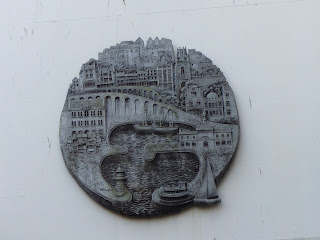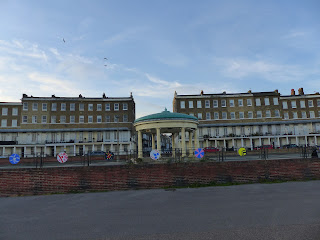John Lewis in History of Thanet written at the beginning of
the 1700s, says:
“When they are boys, they go to catch Whiting and Herring in
the North Seas, whither they make two voyages a year, and come home the latter
one soon enough for the men to go to the wheat season, and take a winter’s
thresh: Which last they have done time enough, to go to sea in the spring.
Besides this there are here two seasons for the home-fishery, which are called
by the inhabitants Shot-fare and herring-fare. The first of these is the
Macarel season which commonly is about the beginning of May, when the sowing of
barley is ended. The other is the season for catching Herrings, which begins
about the end of harvest, and ends soon enough for the wheat season, the time
of sowing which here is about November…
As to the North-Sea fishery, it has formerly been much used
by the inhabitants of this island; but the little success they have met with of
late years, has very much discouraged them from following that employment.
Map from Lewis’s time circa 1720
Anciently the inhabitants of Ramsgate , St Peters and
Bradstowe, lived, it seems very meanly and poorly, eating scarce any thing but
fish, and particularly Red-herrings, and Ling, or North-sea Cod. Meregate was
on account of its Harbour, and trade to London, the principle, if not only
Place of Business, and whose Inhabitants were wealthy, and lived in Plenty; but
Time has made a very great Alteration in these Places. By the Sea’s falling so
heavy in the North Part of the Island, the Harbour of Meregate is gone very
much to decay, and the Masters of ships which used live there are almost all
removed to London, for the sake of Business: So that place is in a manner
deserted by them. Whereas the Town of Ramsgate has all this while been growing
and encreasing, being almost half of it new built, and their Pier being
considerably enlarged; so there are many wealthy Persons among them.”
Lewis goes on to describe the long lines a tackle used for
deep sea cod fishing and although obviously nets were used locally for boat
fishing since prehistoric times, it is very difficult to work out when they
were first used for trawling from here.
From Roman times, and probably before then, Ramsgate Harbour
consisted of the natural bay with the pier extending the sheltered area, much
like Broadstairs is now. The big change came in the latter part of the 1700s
with the building of the much enlarged Ramsgate Harbour.
Although the rebuilt Ramsgate Harbour was primarily to
shelter shipping during storms and justified by the considerable financial
losses to the country’s economy caused by the value of the shipping lost in
these storms, it also became the home to a considerable fishing fleet.
By about 1870 the main form of commercial fishing from
Ramsgate seems to have been trawling, this isn’t that easy to be sure of
because while it is obvious that a boat has the fittings for trawling, it can
also be used for longlineing and drift net fishing.
Apart from the constraint of having a powerful enough boat
to tow the trawl, sufficient manpower to work the gear, the other problem was
preserving the catch, this resulted in a considerable ice business.
Various methods of preserving the catch were used, salting,
a live fish tank in the hold of the boat and iceboxes, all had associated
problems. Much of the work to preserve the catch was done onboard, pickling,
smoking and so on, a life of very hard work.
I think it was partly the regular supply of ice, from about
1870 that caused trawling to increase considerably around that time. The fish
caught in a trawl net would be mostly dead, making it impossible to preserve
them swimming in a tank, so prior to around 1870 most of the deep-sea fishing
seems to have been using the long-line method. This is a long (can be miles
long) fishing line with many baited hooks (hundreds or even thousands). Fish
caught this way would still be alive, suitable species being preserved alive in
seawater tanks, other species either being, smoked or salted for preservation
or discarded.
The peak of the sailing trawler at Ramsgate was between
about 1870 and 1920, after 1920 steam powered trawlers were introduced.
Ramsgate’s prosperity and associated market for fresh fish,
would have started at the beginning of the 1800s when Ramsgate became a
military training depot and the harbour used as an embarkation point for
soldiers associated with the Napoleonic Wars.
 Tanning the canvas,
the Ramsgate sailing trawlers had their canvas tanned, a preservative this shows a sail so
treated, it may belong to the Brixham boat alongside, as she is refitting. The
colour of this “tan” varied from Yellow Ochre to a deep Red Brown.
Tanning the canvas,
the Ramsgate sailing trawlers had their canvas tanned, a preservative this shows a sail so
treated, it may belong to the Brixham boat alongside, as she is refitting. The
colour of this “tan” varied from Yellow Ochre to a deep Red Brown. Ramsgate sailing trawlers putting to sea. The patch of
white on the one in the distance is steam from her winch.
Ramsgate sailing trawlers putting to sea. The patch of
white on the one in the distance is steam from her winch.Our local history books are available via the main Michaelsbookshop.com website.
I'm just starting on Maggie Gee's first book. "Dying in Other Words"
I have just finished the early pat Barker book it used to be called The Century's Daughter.
Very good read but a bit depressing, it's very much focused on the poor lives that British women who were working class got during particularly the first half of the 20th century.
Next photos from my late afternoon walk in Ramsgate. These should expand with a bit of clicking or wosisname.
Most noticeable in the photos is the new Pleasurama development that is taking place on the seafront. I had quite a bit to do with getting the height of this reduced by about 2m. My thoughts at the moment are yes much better than what was there before. Oh my god are we ever going to see any seafront leisure again. Why is the roof so incredibly ugly? And of course the issue do with the cliff and it's terrible state of repair with the bill down to us the local taxpayers I think it's one of the worst decisions to have come out of the Sandy Ezekiel government at Thanet District council.
Oh yes and of course today's painting. If you look at my main Facebook profile here is the link you will note that I have been doing a lot of portrait painting and now I have started doing figure painting.
This one is about halfway I paint the figures in very roughly and then put the clothes on them otherwise the hands and feet are sticking out in the wrong places.I meant to buy a carrot so I could get the carrot to look more like carrot, but I forgot.








































Note ferry at Sandwich. What date is the map and when was Sandwich tgoll bridge built?
ReplyDelete